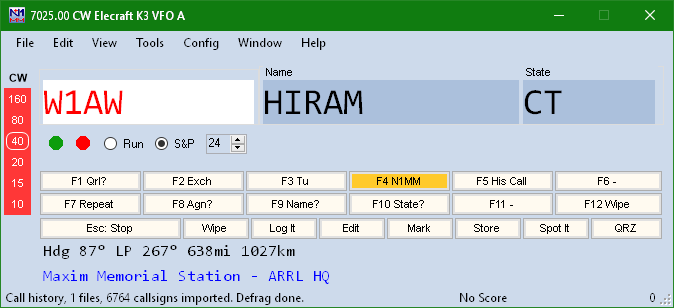With my first foray’s into HF in the past few months, I’ve been diligently trying to track all of my contacts, and confirm the ones that are special to me. To that end, I’ve been pursuing the age-old art of sending QSL cards and the new-age art of electronic QSLing.
For my everyday logging, I’ve mostly been using the DXLab suite of software, which includes a fairly full featured logger, as well as rig control capability, DX cluster access, licensee address lookup, PSK modem, and many other features. And its free! For the couple of contests I’ve taken part in (the CA QSO Party, and the AZ and PA QSO Parties), I’ve used N1MM+, which makes entering contest exchanges snappy and straightforward. Also free! Once the contests are done, I’ve been exporting the contest contacts as an ADIF (amateur data interchange format) file and importing them into DXLabs.

DXLabs also makes uploading contacts directly to both ARRL’s Logbook of the World and eQSL.cc, two of the most popular digital QSLing services. While the LOTW setup is a little onerous, now that I’ve gone through the process of getting the TQSL verification software setup and confirmed on my computer, uploading logs and confirmations to LOTW is as simple as clicking one button. And for the number of confirmations I’ve received through both services, the setup effort has been totally worth it.

That said, not everyone is interested in being a part of the digital QSLing services. It seems many more hams on HF still pursue the older style of confirming confirmations with QSL cards. I too am diving in the the world of physical QSL cards, and I must say, there’s something delightful about having a physical bit of ephemora to hang on the way, to prove that my handful of watts of RF reached out across the country.
On the sending end of the equation, I designed a basic QSL card from scratch in Illustrator. It includes all the basic information to confirm a contact (callsigns, date, UTC time, band, mode and RST), as well as some fun supplementary information (my rig, antenna, and power for each QSO). It’s not fancy, just to-the-point and designed to be printed on my greyscale printer at home. I purchased a small pack of nice cardstock to print these off as necessary, four to a page.

To date, I’ve sent out about a dozen physical QSL cards. Some went to folks in states I’d like to confirm who aren’t on LOTW. Some went to my first contacts on the various HF Bands, or my first CW contact ever, and so on. Some just went to interesting people who I had nice conversations with. Out of those dozen or so cards that have gone out (with self-addressed stamped envelopes enclosed), I’ve gotten five back. And they’re all great!
Now I’m looking for a way to display these cards, and hopefully more that I’ll acquire in the future.
Hear you on the air!
73
For more information on QSLing, past and present, some resources I recommend are:

Postcards run in the family.
LikeLike